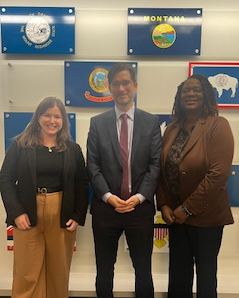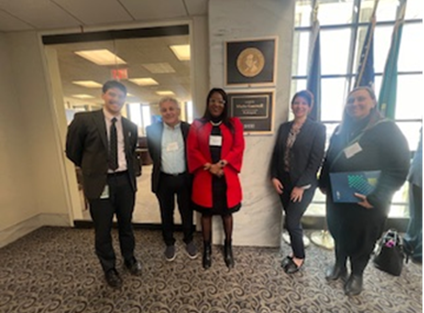Federal Housing Policy: Today’s challenges call for future change
One of HPN’s great advantages is our ability to draw on the experience and expertise of our members across the country to fuel social and economic justice, particularly around affordable housing.
Our 2024 federal policy discussions in Washington, D.C. further proved that value. Our first in-person policy convening in five years, this forum gave HPN’s staff and members from 25 organizations the chance to share what’s happening in their organizations and the sector and inform public officials what’s happening on the ground in the communities where we all work.
We’re grateful for the support of JPMorgan Chase for joining and supporting this peer exchange. Notably, Chase is the only financial institution of its size to invest in its own PolicyCenter to drive inclusive economic growth in the U.S. and beyond. We also heard from officials at HUD, Treasury, FHA and National Council of State Housing Agencies on what they need from us to advance valuable programs, as they shared strategies and experiences that might benefit developers, projects, and residents.
During our visit to DC, HPN members and staff visited 52 Congressional offices from across the country and both political parties to illustrate the impact of the housing crisis on millions of people and explain the impediments to progress. I joined HPN members Long Island Housing Partnership, Inc. to visit with Majority Leader Chuck Schumer’s staff and CHN Housing Partners to visit the offices of Senators Gary Peters and J.D. Vance. I was impressed with the optimism of Congressional staff and their response to HPN’s members work and passion for communities.
Finally, we convened leaders from 14 other national housing organizations for a roundtable discussion about policy priorities and coalition-building that I think hold great promise for the future. It was a welcome continuation of the one-on-one strategy conversations that I had with leading housing groups last year.
As for takeaways, I think it’s worth highlighting a number of compelling challenges and ideas that came up in meetings and conversations that can help us target our outreach, messaging and policy plans going forward:
- Major headwinds: During COVID-19, affordable housing organizations became first responders, working around the clock and investing millions to keep people safely and stably housed. Now these same nonprofits are facing a perfect storm of crises. The end of rent relief and eviction bans ran headfirst into inflation, leaving tenants to deal with rent arrears, rising rents and cost hikes in basic goods and services . In turn mission-driven landlords are grappling with rent shortfalls, sharp increases in operating costs, from staffing to rising interest and insurance rates, and aging portfolios needing capital infusion. It’s a post-pandemic crisis that is hidden from the general public.
- Narrative change: It was clear from our discussions that though the pressure on affordable housing portfolios has been widespread (see above), the magnitude of this impact is not broadly understood. Those of us who do this work every day already know that investing in the housing ecosystem is as important to solving the current crisis as is financing for individual projects. But we need more real-world data and an improved narrative to illustrate the importance of affordable housing to communities, the unprecedented stress the system is under, and the need to return to historical levels of housing production to make a difference.
- Increasing demands for capital: As interest rates have risen and conventional lenders have tightened credit, affordable housing developers and other local organizations are relying more and more on community development financial institutions (CDFIs) to fill gaps. This is not news for HPN members, but it may not be as evident to high-level policy makers. Can we help federal officials identify tools that expand the capacity of CDFIs to meet these needs? Can we go beyond existing tools to find new ways to attract capital to the sector? We heard officials say that they want to hear more about financing challenges and to deepen conversations about the value of CDFI engagement and investments. We can help make clear how imperative impact-first lenders and investors are to economic mobility in our communities, as well as long-term economic growth.
This is just a snapshot of our conversations with policymakers and housing leaders, but I think it points to some encouraging signs amid difficult conditions. It was clear that public officials want more information, more stories and more real-world data and market intelligence about the state of housing in our country, and our housing colleagues want to share information and collaborate. The feedback from HPN members who participated also offers insight into new opportunities. This kind of outreach, both within and beyond HPN, is a priority for our leadership team. I hope you will think about how your own perspectives can contribute to these ongoing efforts.
If you have stories, suggestions, or information that you think might be of value, please reach out to me on LinkedIn.


